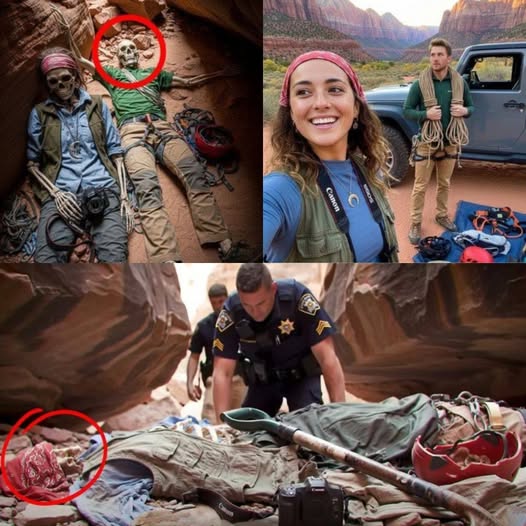The dust of Zion tastes like memory. For years, Elias Thorne had felt it coating his tongue—a fine grit of sandstone and sorrow. Every morning it gathered on his windowsill, pale as ash, settling into the corners of the small cabin that overlooked the canyon. It was inescapable, no matter how tightly he sealed the door, no matter how many times he swept the floor. The dust found its way in, as if the desert itself refused to let him forget.
He hadn’t spoken aloud in three days. The only sound was the occasional rustle of wind through the red cliffs, or the cry of a hawk circling the ridge. Once, the silence comforted him. Now it accused him.
Elias had come to Zion ten years ago with a camera and a purpose—to capture what was left of the sacred in a land that had long since traded awe for photographs and tickets. Back then, he was still Professor Thorne, lecturer of anthropology at a quiet university, a man with a wife who smiled at him over morning coffee and a daughter who thought the world began and ended in the strength of his arms.
But that was before the accident. Before the river took her.

I. The River and the Silence
It was an early spring afternoon, ten years past. The Virgin River was swollen with rain, the air thick with thunder. Elias had been photographing the narrow canyon when his daughter, Mira, darted too close to the edge. He remembered shouting her name—the syllable echoing against the walls like a command to the heavens.
Then there was the slip. The scream. The silence.
They found her body two miles downstream. She was nine years old.
The next morning, his wife left him a note on the kitchen counter:
“I can’t breathe here. Not with the river singing her name.”
He didn’t blame her. He just packed his camera and went back to the canyon, as if penance could be paid through proximity.
II. The Pilgrims of the Desert
By the third year of solitude, Elias had become something of a local ghost. The park rangers called him The Watcher of Angels Landing. Tourists spoke of glimpsing him at sunrise, standing motionless with a camera, his figure silhouetted against the cliffs like a monument carved from grief.
He rarely spoke to anyone, except to the occasional hiker who lost their way. Some of them came seeking miracles. Zion had become a kind of modern shrine—a place where people came to shed their lives, to bury their mistakes in the dust.
There was the veteran who scattered ashes and whispered apologies to the wind.
The young woman who left her engagement ring beneath a juniper tree.
The pastor who came to test his faith and found only echoes.
Elias watched them all with quiet understanding. They were pilgrims, each tasting their own dust of memory. He never told them his story. The canyon already knew it.
III. The Stranger
It was late autumn when she appeared.
He first saw her from a distance—a figure walking along the edge of the east rim, moving with the uncertain steps of someone unfamiliar with the land. She wore a wide hat, a faded blue coat, and carried a satchel slung across her shoulder.
By sunset, she had found her way to his cabin.
“Are you Elias Thorne?” she asked, her voice trembling slightly. “The photographer?”
He hesitated. It had been years since anyone used his full name.
“I was,” he said. “Once.”
She smiled faintly. “Then you’re the man I’ve been looking for.”
Her name was Clara, and she carried a letter from a museum in Salt Lake City. They were preparing an exhibition titled “The Memory of Earth: Lost Landscapes of the Southwest.” She told him they wanted to feature his early work—images from his travels through the desert in the 1990s, photographs that had since become collector’s items.
But there was something else in her eyes. Something unspoken.
She unrolled a map on his table, and beneath it slipped a photograph. Elias froze.
It was Mira—his daughter—standing beside the old canyon sign, a shy smile on her face, holding the same camera he still kept on the shelf.
“Where did you get this?” he whispered.
Clara hesitated. “It was in your university’s archives. It came with a note addressed to you. I was told to deliver it personally.”
IV. The Letter
Elias unfolded the paper, the edges yellowed with time.
Dear Elias,
If you’re reading this, it means I’ve gone ahead before you. I’ve kept one secret too long: that photograph of Mira wasn’t the last we took. There was another roll—one you never developed. It was in my drawer, labeled “The River.” You said you’d come back for it, but you never did.
You once told me that memory is sacred only when shared. Maybe it’s time to remember her not through grief, but through the light she left behind.
—H.
It was his wife’s handwriting.
Elias sat in silence, feeling the words press against his chest like stones. He remembered the day she took that last roll of film. Mira had been laughing, chasing dragonflies near the water. He had been too afraid to photograph her after the accident—too afraid to let joy exist in that place again.
But now, the letter made something stir inside him. A flicker of the old instinct, the artist’s call to witness.
He looked up at Clara. “Will you take me there?”
She nodded.
V. The Return to the River
They set out at dawn. The canyon was cool, the sun still a shy ember on the horizon. Elias carried his old camera around his neck, the strap frayed but familiar.
As they walked, he told Clara about the years before—the laughter that once filled these canyons, the dreams he’d buried in the dust. She listened without interrupting. Sometimes silence was the only language that fit grief.
When they reached the riverbank, the wind shifted. The air smelled of rain and iron. Elias knelt, touching the earth where the water met the stone.
“This is where she fell,” he said softly.
Clara didn’t move. She only placed a small flower on the river’s edge, then stepped back.
Elias raised the camera. Through the viewfinder, the world returned to focus: the curve of the water, the shimmer of morning light, the ghosts of memory in every ripple.
For the first time in a decade, he pressed the shutter.
The sound was like a heartbeat—steady, alive.
He took another shot, and another. Each click felt like forgiveness.
VI. The Revelation
By the time they returned to the cabin, the sun was already setting. Elias developed the photographs in his darkroom, his hands trembling as the images began to form on the paper.
At first, they were simple landscapes—the canyon walls, the silver line of the river, the shadow of a bird in flight. But then, one photograph stopped him cold.
It was the reflection of a girl in the water, faint but unmistakable.
Her hair caught the light. Her smile—his daughter’s smile—was there, framed by the ripples.
Clara saw it too.
“Do you see her?” she whispered.
Elias nodded, tears welling. “I see her.”
He knew it wasn’t a ghost, not in the literal sense. It was the echo of light, a trick of water and memory. But for Elias, it was enough.
He placed the photo on the table beside his wife’s letter. The dust on his hands no longer felt like a burden. It felt like belonging.
VII. The Gift
Weeks later, the exhibition opened in Salt Lake City. Elias hadn’t planned to attend, but Clara insisted. When he arrived, the gallery was crowded, filled with scholars, artists, and wanderers drawn by the allure of the desert.
At the center of the room hung his photograph—The River, Zion, 2024. The reflection of the child glimmered faintly under the light, as if breathing.
Beneath it, a single line was printed:
“The dust of Zion tastes like memory.”
The audience was silent. Some wept. Some simply stood still.
A journalist asked him what the image meant.
Elias smiled gently and said, “It means she’s home.”
VIII. The Last Morning
When Elias returned to his cabin, he opened the windows wide. The morning sun poured in, and with it came the dust—the same fine grit of sandstone that had haunted him for years.
He didn’t sweep it away this time. He let it settle on his hands, his camera, the letter, the photo.
He realized then that Zion had never been punishing him. It had been keeping him—guarding him—until he was ready to remember not just what he’d lost, but what he still carried.
That evening, Clara came by to say goodbye. She was leaving for another project, somewhere in the Navajo lands. Elias thanked her quietly, and as she turned to go, he handed her a small envelope.
Inside was a photograph—the reflection of the girl in the river.
“For you,” he said. “To remind you that memory isn’t something we escape. It’s something we honor.”
IX. The Dust Settles
Long after she was gone, Elias sat by the window watching the canyon darken. The stars began to emerge, scattered like ancient embers.
He thought of Mira, of her laughter echoing through the rocks, and of his wife’s final words about light and memory.
He took a deep breath. The air was dry, the dust thick on his tongue—but this time, it didn’t taste like sorrow.
It tasted like home.


